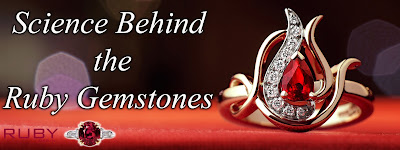Science behind the ruby gemstones
What do you think of when you hear of the color red? Does it remind you of love or passion? Or do you think of the beautiful and the most expensive of all gemstones – the Ruby stone?
Well, just like many intense things and feelings in the life, the ruby gemstone is also associated with red and represents the color incredibly. As a matter of fact, the name “ruby” is derived from “ruber” which means red in Latin.
The Science of Ruby:
Ruby is the red variant of mineral corundum and is famous for its bright color, durability, and luster. The chemical formula of corundum is Al2O3 – which means is formed of aluminum oxide which contains two aluminum atoms and three oxygen atoms. The chemicals are packed in a close hexagonal structure. And the mineral consists of iron, vanadium, titanium, and/or chromium. The presence of chromium traces results in the color red of the beautiful ruby stone.
Chromium (Cr) has 24 as its atomic number. It is basically a great colored metal that is a bit glossy, but at the same time, it is hard yet brittle. Its melting point is over 3,400 Fahrenheit.
Ruby Quality:
The quality of rubies depends on their origin and formation. The highest quality ruby gemstones are usually formed in marble. The presence of low iron in the gem gives these gems intense red colors. But, that’s not it; marble also gives birth to the expensive fluorescent rubies.
Other than marbles, basalt rocks also form rubies. However, as they contain more iron than the marble deposits, basal rocks produce dark and much less vibrant rubies. A very high quality and much-demanded variety of these gemstones is the one mined in Myanmar (Burma). Other than this region, places like Madagascar, Thailand, and Mozambique also provide great rubies.
Ruby Grading:
Grading a ruby is absolutely important to find the right ruby stone price. For grading this gem, its color and clarity are taken into consideration.
Chromium, the presence of inclusions and fluorescence in the gem has a bearing on its color. Fluorescent rubies emit their light once they absorb the ultraviolet light and have an intense color with an increased ruby price. The color is also dependent on the hue, tone, and saturation.
Then, comes the clarity of the stone. While finding a purely transparent ruby is extremely difficult, such a natural stone comes at a premium price. Also, having inclusions isn’t a bad thing at all. In fact, a ruby that has no rutile needle inclusions could be a synthetic one, or it may have undergone some treatments.
Some inclusions even increase the value of the stone. These inclusions include rutile silk that may create a wonderful star effect called asterism that results in scattering of light and spreading the color evenly on the crown of the ruby.
The value of a ruby has a lot to do with its inclusions. A ruby stone inclusions may not command a great price as these may result in a decrease of the transparency and brilliance of the gem, and may even lower their durability.
Ruby Treatments:
Many gems require treatments in order to improve their quality and appearance. While too many treatments are not acceptable, some of them are acceptable, depending on the condition of the gem and the improvement that it needs.
One of the most common ruby treatment is heat treatment which is done to improve the color of the Manik stone. Heat treatment helps in removing the purple and blue hues if any and also silk inclusions to an extent. Undergoing such a treatment brings out the true, vivid color of the ruby stone and makes it look all the more amazing. These treatments are usually performed at temperatures that range around 1800 °C (3300 °F).
Other treatments may include color alteration that is done to improve the transparency of the stone. This is done by softening rutile inclusions, mending cracks or fractures, and at times, entirely filling these cracks.
One more treatment that has gained popularity in the past few years is lead glass filling. As the name suggests, in this treatment, the ruby stone’s fractures are filled with lead glass to finetune its transparency and make it perfect to adorn jewelry.




Comments
Post a Comment